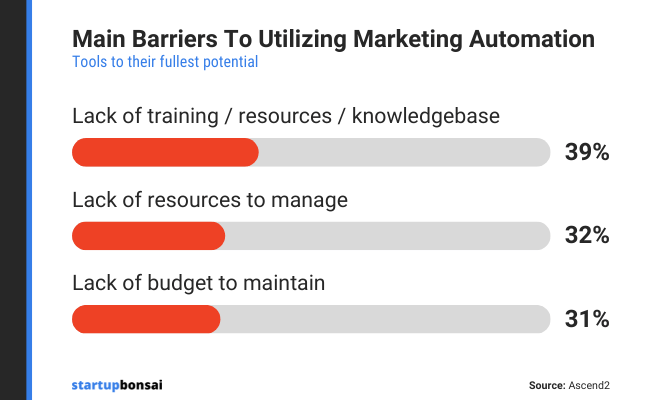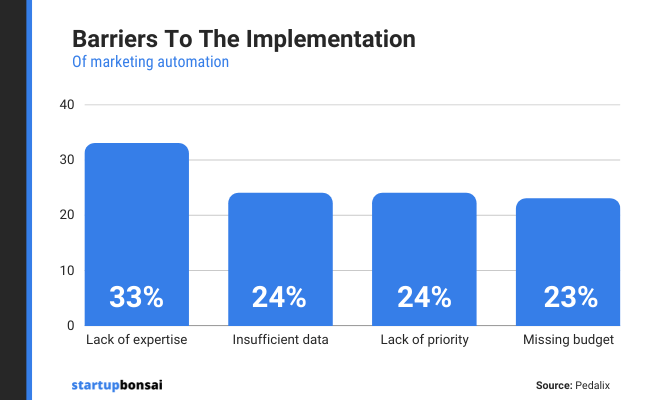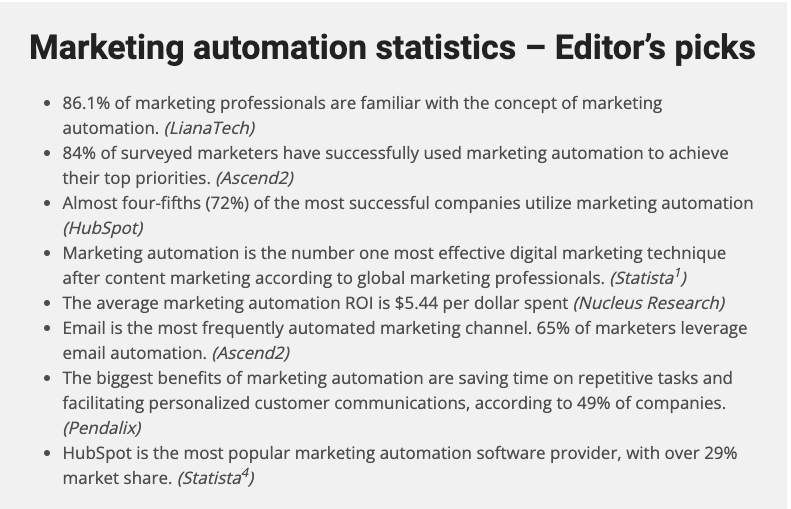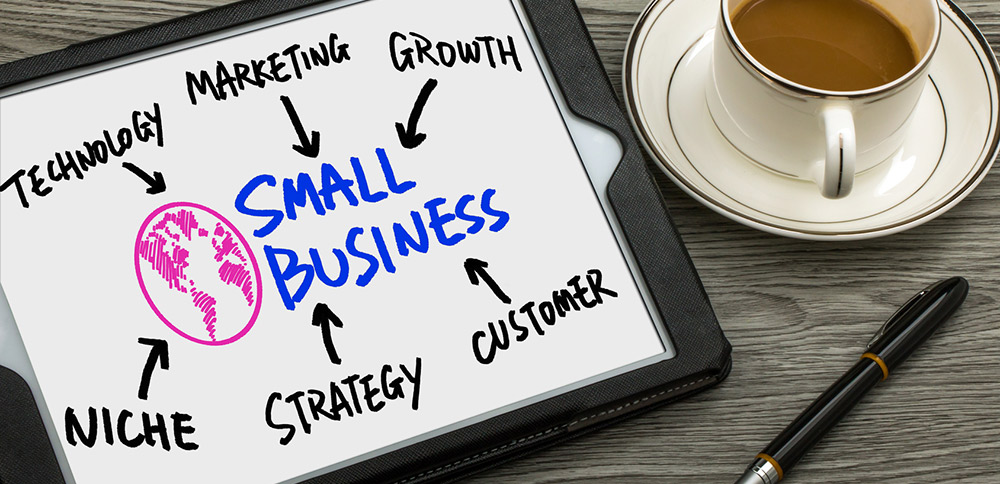
The Power of B2B Marketing Automation – How it works…
If you’re looking for ways to improve and streamline your marketing efforts then marketing automation might just be the unicorn you’re looking for. It will take some planning and effort to get started but once it is performing you’ll wonder why you didn’t start sooner.
Marketing automation is the use of software and technology to automate marketing tasks and processes, such as email campaigns, social media management, and lead generation. It allows businesses to target, engage, and convert their audience more efficiently, freeing up time and resources that can be used for other tasks.
Here are some marketing automation statistics gathered by StartupBonsai:
A lack of clear instructions makes building an online presence challenging for B2B companies. To be successful online, your business must have clear goals and understand how online marketing works.
This post will give you some clarity and help you decide whether automation is what you need.
There are several benefits of marketing automation for businesses of all sizes:
- Increased efficiency and productivity: It saves time and effort by automating repetitive tasks, such as sending emails and social media posts. This allows marketers to focus on high-value tasks, such as analyzing data and creating strategic campaigns.
- Improved targeting and personalization: Marketing automation allows businesses to segment their audience and create targeted campaigns based on specific criteria, such as location, demographics, and behavior. This level of personalization can help increase engagement and conversion rates.
- Enhanced lead generation and nurturing: It can help businesses generate and nurture leads through targeted campaigns, such as email drip campaigns and lead-scoring programs.
- Better analysis and measurement: Detailed analytics and reporting are a big benefit of automation software. This allows businesses to track the effectiveness of their campaigns and make data-driven decisions.
The ROI of a successful marketing automation campaign can be significant. According to a survey by the Data & Marketing Association, businesses that use marketing automation see an average ROI of around 300%. This is because the automation allows businesses to reach their audience more effectively, resulting in higher conversion rates and increased revenue.
To get the most out of it, it is important to have a clear strategy in place and to use the right tools and technology.
When it’s done wrong, a campaign can also fail miserably. Do testing on a small scale first and then scale it when you have it fine tuned. It is also important to continuously test and optimize campaigns to ensure that they are delivering the desired results. With a well-executed campaign, businesses can achieve significant growth and success.
What does marketing automation actually do?
By automating and streamline marketing tasks, companies can find more time to put into actually closing deals and building relationships. Automated tasks can include a wide range of activities, such as email marketing, social media management, lead generation, and customer segmentation.
Some specific tasks that automation can perform include:
- Email marketing: It can send targeted and personalized emails to specific segments of a business’s audience. This can include newsletters, promotional emails, and automated drip campaigns.
- Social media management: Marketing automation can help businesses schedule and publish social media posts, as well as track and analyze the performance of these posts.
- Lead generation: Marketing automation can help businesses generate leads through targeted campaigns, such as lead-scoring programs and landing page optimization.
- Customer segmentation: Automation can segment a business’s audience based on specific criteria, such as location, demographics, and behavior. This allows businesses to create targeted campaigns that are more relevant and effective.
How does marketing automation work?
Marketing automation works by using software and technology to automate and streamline marketing tasks and processes. Here is a general overview of how automation works:
- Set up: The first step is setting up the software and defining the goals and strategy for the campaign. This includes selecting the appropriate tools and technology, such as email marketing software or social media management platforms.
- Audience segmentation: Marketing automation allows businesses to segment their audience based on specific criteria, such as location, demographics, and behavior. This allows businesses to create targeted campaigns that are more relevant and effective.
- Campaign creation: Set up email drip campaigns and social media posts. These campaigns can be triggered by specific actions, such as filling out a form or making a purchase.
- Delivery and tracking: Delivers the campaigns to the appropriate segments of the audience and tracks the performance of the campaigns. This includes measuring metrics such as open rates, click-through rates, and conversion rates.
- Analysis and optimization: The detailed analytics and reporting, allows businesses to track the effectiveness of their campaigns and make data-driven decisions. This includes identifying what is working well and what can be improved upon.
What does marketing automation mean for the customer journey?
Automation can have a significant impact on the customer journey, as it allows businesses to deliver personalized and relevant experiences to their customers throughout the entire customer journey.
Here are a few ways in which marketing automation can enhance the customer journey:
- Lead generation and nurturing: Marketing automation can help businesses generate and nurture leads through targeted campaigns, such as email drip campaigns and lead-scoring programs. This can help businesses guide potential customers through the sales funnel and convert them into paying customers.
- Personalization: Marketing automation allows businesses to segment their audience and create targeted campaigns based on specific criteria, such as location, demographics, and behavior. This level of personalization can help increase engagement and conversion rates.
- Customer segmentation: Marketing automation can segment a business’s audience based on specific criteria, such as location, demographics, and behavior. This allows businesses to create targeted campaigns that are more relevant and effective, improving the overall customer experience.
- Customer service: Marketing automation can also be used to provide customer service, such as answering frequently asked questions or providing personalized recommendations. This can help businesses improve customer satisfaction and loyalty.
By following these best practices, businesses can ensure that their marketing automation campaigns are successful and deliver the desired results.
What are common problems that marketing automation can solve?
Automation can help businesses solve a variety of problems, including:
- Lack of time and resources: Aave time and effort by automating repetitive tasks, such as sending emails and social media posts. This allows businesses to focus on high-value tasks, such as analyzing data and creating strategic campaigns.
- Lack of personalization: Businesses can segment their audience and create targeted campaigns based on specific criteria, such as location, demographics, and behavior. This level of personalization can help increase engagement and conversion rates.
- Inefficient lead generation and nurturing: It helps businesses generate and nurture leads through targeted campaigns, such as email drip campaigns and lead-scoring programs. This can help businesses convert more leads into paying customers.
- Difficulty measuring and analyzing campaigns: Marketing automation provides detailed analytics and reporting, allowing businesses to track the effectiveness of their campaigns and make data-driven decisions. This can help businesses identify what is working well and what can be improved upon.
When asked why they think they’re not utilizing their tools properly, marketers identified the following barriers:

- 39% of respondents said they lacked the training to fully utilize marketing automation software.
- 32% said they did not have the resources to manage the automation process.
- 31% of respondents reported that maintaining their tools was beyond their budget.
- 25% of respondents cited a difficult setup process as the issue.
According to another study, respondents identified several challenges when implementing marketing automation:

33% of surveyed companies identified a lack of expertise as the biggest obstacle preventing them from implementing marketing automation.
Overall, marketing automation can help businesses solve a variety of problems by streamlining repetitive tasks and allowing marketers to focus on high-value activities, such as analyzing data and creating strategic campaigns. It also helps businesses reach their audience more effectively and increase conversion rates, leading to increased revenue and growth.
At OCEANONE Design our marketing platform of choice is VBOUT. It’s a comprehensive online marketing application that really has no limitations since it can easily integrate with all other modern applications that use an API. For instance, if our client likes to use the popular Hubspot CRM, we can easily connect to it so that leads from Facebook, email or any other campaigns will be sent directly to the their CRM. We can also alert them via text message if they prefer.
Many clients tell us that the high cost of software and complexity are the barriers that hold them back from going all-in with automation. If that’s the case for you, we can help. We can set you up using our software to run the campaigns and connect to your free CRM. That way there is no software cost to you. As you grow, you can invest in your own system and hire staff to run it.
Don’t get left behind, contact us anytime for a free consultation.





